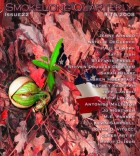The second-person POV often feels risky to me, its very nature inviting readers in and/or pushing them away. What risks/benefits do you see for those working with the 2nd person POV?
There are a couple of flavors of second person. The beautifully constructed novel The Poisonwood Bible begins with a first and second person narrative, where the ‘you’ is clearly defined as the reader who is free to form his or her own conclusions. Then there is the riskier situation in which the ‘you’ is not the reader but a character in the story. I think there is risk in alienating the reader. It can be discombobulating to constantly feel as though you are being addressed when in fact you aren’t. The reward, in my opinion, is an immediacy and an intimacy that I think is hard to match in other POVs. It makes everyone a participant in the action. Because it sometimes taxes the reader, it works great in flash. Maybe harder to pull off in longer pieces.
How does that 2nd person POV work perfectly for “Waiting for a Private Room?”
I think it acts to draw readers into the fragile mental state of both the narrator and the main character and the delicate nature of their relationship, to force the reader to sit right down next to the narrator and endure it whether they want to or not.
“Waiting for a Private Room” begins with a Shade, ends with a Window. Somewhere, perhaps, in-between, there’s the Pane. What of windows and shades?
I wish I could say I intended something profound with the windows. I do think it speaks to isolation in this piece.
I so love the use of Zeugma, as seen in “the swirl of kids and snow,” with the “swirl of” taking its two surprising objects. What would be missing from this piece if the kids weren’t there?
If the kids aren’t there, I think the piece loses a benchmark for reality before the addiction. The kids just need a piece of cardboard and a hill covered with snow to make them happy.
Begin this answer with the words, “I write.” Complete the sentence. Then, write as many sentences as you’d like, each one beginning with that “I write….”
I write when I can, usually in the middle of the night. I write the revision during the daytime, and I am always surprised at how grammar standards change depending on whether the sun is up or down.



 The SmokeLong Grand Micro Contest (The Mikey) is now an annual competition celebrating and compensating the best micro fiction and nonfiction online.
The SmokeLong Grand Micro Contest (The Mikey) is now an annual competition celebrating and compensating the best micro fiction and nonfiction online.